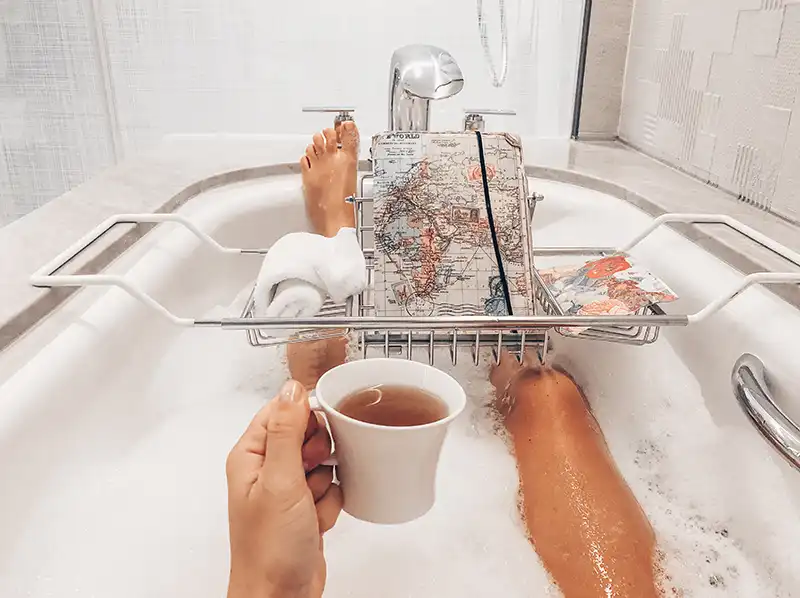Natural Remedies for Menopause
Menopause can be an overwhelming experience, with its range of unwelcome symptoms that can last for months or even years. From hot flushes and night sweats to mood swings and low energy levels, it can be a trying time for many women. But don’t despair, because there are natural remedies for menopause that can help alleviate its symptoms.
We all have different experiences when it comes to menopause, but there are some tried-and-tested natural remedies that can help ease the transition. From diet and exercise, to herbal supplements and lifestyle changes, there are plenty of ways to make it a little easier. So, if you’re looking for ways to manage your symptoms and mood swings, read on to find out how natural remedies can help you through your menopause journey.
Herbal Supplements
Herbal supplements have been long used to help manage menopause-related symptoms. Three of the most popular ones are Black Cohosh, Chasteberry, and Dong Quai.
Black Cohosh is known for helping with hot flashes and night sweats. It can also help with sleep issues and mood swings.
Chasteberry is a great go-to for hormone balance. It’s usually used to help with irregular periods, and can even help with PMS.
Dong Quai is another powerful supplement.
Black Cohosh
Moving on from hormones, let’s take a closer look at herbal supplements, starting with Black Cohosh. This popular herb is commonly used to treat the symptoms of menopause, such as hot flashes and mood swings. It’s even been found to help reduce night sweats. Plus, it’s pretty easy to take—just make sure you get the right dose. But, be aware that it can have some side effects like headaches, nausea, and stomach cramps. So, it’s best to consult your doctor before taking it.
Chasteberry
Moving on from herbal remedies, let’s take a look at herbal supplements; specifically, chasteberry. Chasteberry, also known as vitex, is an herb used to treat a variety of medical conditions linked to hormones, such as premenstrual syndrome and menopause. It’s believed to work by altering hormone levels and reducing inflammation. Studies have shown that taking chasteberry can help reduce hot flashes, night sweats, and mood swings.
Chasteberry is often used in traditional medicine to treat a variety of medical conditions, but research is limited and inconclusive. Most of the studies that have been done have small sample sizes, making it difficult to draw definite conclusions. It’s important to note that chasteberry is not recommended for pregnant or breastfeeding women, as it can cause complications.
In conclusion, chasteberry can be an effective treatment for hormonal imbalances and menopausal symptoms, but more research is needed to fully understand its effects.
Dong Quai
Moving on from black cohosh and chasteberry, let’s explore the effects of dong quai. Also known as Chinese angelica, this herb has been used for centuries in traditional Chinese medicine. Dong quai is said to help regulate hormones that can cause mood swings and other menopause symptoms. Unlike some of the other herbal remedies, Dong Quai may also have a positive effect on energy levels and even skin health. And although it can’t solve all your menopause problems, it could be a useful addition to your daily wellness routine.
If you’re looking to give Dong Quai a try, be sure to purchase it from a reliable source and take it in the correct dosage. You should always consult with your doctor before taking any herbal supplements, especially if you’re currently taking prescription medications. But if you’re looking for a natural way to manage your menopause symptoms, dong quai could be the right choice for you.
Diet and Nutrition
In terms of diet and nutrition, it’s important to eat foods rich in calcium and vitamin D, reduce sugar and refined carbs, and increase omega-3 fatty acids. These three changes will help keep your body in good shape.
Calcium is essential for strong bones and teeth, and vitamin D helps your body absorb calcium. So, make sure you get enough of these two nutrients by eating dairy, green leafy vegetables, and fish.
Sugar and refined carbohydrates are bad for your health, so limit your intake of processed foods. Try to stick to vegetables, fruits, and whole grains instead.
Eat Foods Rich in Calcium and Vitamin D
Now it’s time to take a look at diet and nutrition – and specifically, what we can do to get those all important calcium and vitamin D levels up! 💡 Let’s face it, we all want to feel strong and healthy, and getting enough of these vitamins can really help.
It’s easy to think that just taking a supplement is enough, but it’s always best to get your vitamins from natural sources. That’s why it’s important to make sure you’re eating foods that are rich in calcium and vitamin D. These include dairy products, dark green vegetables, and fish like salmon and tuna. Including these in your diet can help you maintain strong bones, healthy teeth, and even a better mood!
So, don’t forget to add more calcium and vitamin D-rich foods into your daily meals. It’s easy to do, and it can make a huge difference to your overall wellbeing.
Reduce Sugar and Refined Carbohydrates
Now that we’ve talked about the health benefits of herbal supplements, let’s move on to our next topic: diet and nutrition. Let’s start with the most important thing: reducing sugar and refined carbohydrates. After all, sugar is like kryptonite to our health.
Refined carbohydrates, like white bread, pastries, and sugary drinks, can raise blood sugar, causing inflammation and weight gain. They also lack the vital nutrients our bodies need. So, it’s best to limit these items and instead, focus on filling our diets with wholesome, nutrient-dense foods.
Swapping out refined carbs for healthier options can help us look and feel our best. Plus, it gives us more energy to tackle our day. So, let’s make a commitment to choose more nutrient-rich foods, like vegetables, fruits, nuts, and whole grains. It’ll be a great first step towards improving our diet and health.
Increase Omega-3 Fatty Acids
Moving on from herbal supplements, let’s discuss one of the best ways to ensure your diet is providing you with the nutrition you need: increasing omega-3 fatty acids. Omega-3s are essential fatty acids that are vital for a wide range of bodily functions and play an important role in keeping us healthy. But how can you increase your omega-3 intake?
One of the easiest ways is to start incorporating more fatty fish into your diet. Fish such as salmon, mackerel, and herring are all great sources of omega-3 fatty acids, and have many other health benefits as well. If you’re not a fan of fish, you can always take a fish oil supplement in order to get your daily dosage.
If you’re looking to get creative in the kitchen, you can also try cooking with oils such as flaxseed, walnut, canola, and soybean. These oils are also rich in omega-3 fatty acids, and can be used in a variety of recipes.
Exercise
When it comes to exercise, I’m sure yoga, meditation, and aerobic activity come to mind. They’re all great ways to get our bodies moving and stay healthy. Yoga is a great way to improve strength and flexibility, while meditation can help us relax and de-stress. Aerobic exercise is a great way to get your heart rate up and burn some calories. All three of these activities have their own benefits and can help us stay in shape and feel our best. So why not try each one and find out what works best for you? You won’t regret it! It’s time to get moving!
Yoga
Moving on from diet and nutrition, exercise plays a vital role in overall health – and yoga is a great way to get started! Not only is yoga excellent for strengthening and flexibility, but it can also help with emotional wellbeing. It’s the perfect way to relax, de-stress and get into a great headspace. Plus, it doesn’t require a lot of equipment or a big commitment – just a yoga mat and a bit of dedication and you’re ready to go! Of course, guided classes can help if you’re a beginner, but if you want to go it alone, it’s totally doable. So why not give it a go? You may just find it’s the perfect addition to your fitness routine.
Meditation
Now that you’ve got your diet and nutrition in check, let’s jump into the next level of taking care of yourself: Exercise! And what better way to get in touch with your inner self than through Yoga, Meditation, and Aerobic Exercise? Meditation can be a great way to reduce stress and anxiety, and to also cultivate inner peace. Plus, it’s so easy to do – no equipment required!
Just find a comfortable spot, whether that’s in your bedroom, on the couch, or even outside. Once you get settled, focus on your breathing and try to clear your mind of any intrusive thoughts. For additional guidance, try playing a guided meditation on your phone – it can be incredibly calming and centering.
If you’re just starting out with meditation, don’t worry if your mind keeps wandering; this is totally normal. Just be patient and kind with yourself, and gradually you’ll start to notice the benefits of regular meditation.
Aerobic Exercise
Now that we’ve covered nutrition for our bodies, it’s time to talk about exercise. Sure, you’ve heard it all before – it’s good for you, it’s an important part of maintaining a healthy lifestyle. But what types of exercise should you be doing? One of the best types of workouts for women is aerobic exercise.
Aerobic exercise can be anything from a brisk walk to a high-intensity cardio class. It’s all about getting your heart rate up for an extended period of time. And the best part? You can do it almost anywhere, from the comfort of your own living room to the great outdoors. Plus, it’s a great way to boost your endorphins and lift your mood.
If you’re just getting started, don’t worry – you don’t have to jump into the deep end straight away. Start off small. Take a few 15 minute walks during your lunch break, or try a gentle yoga class once a week.
Relaxation and Stress Reduction

I’m sure you’ve heard of relaxation and stress reduction techniques, like deep breathing, progressive muscle relaxation, and mindfulness practices. But, have you tried any of ’em? I know I haven’t. 🤷
As menopausal women, it’s so important to take the time and find ways to relax and reduce stress levels. Let’s start with deep breathing exercises. Taking a few deep breaths can help trigger your body’s relaxation response, leading to a more peaceful state of being.
Next up is progressive muscle relaxation. This technique involves tensing and then relaxing different muscle groups.
Breathing Exercises
After getting your heart rate up with exercise, it’s time to relax, unwind, and take a few deep breaths. Breathing exercises are an excellent way to reduce stress, clear your mind, and focus your energy on the present moment.
For a quick and easy breath-focusing exercise, find a comfortable position in a quiet place, close your eyes, and take a few slow, deep breaths. As you inhale, imagine yourself filling up with a bright and calming energy. As you exhale, imagine all of your worries and stress flowing out of your body with each breath. This simple technique can help you relax, refocus, and re-energize.
Another effective breathing exercise is alternate nostril breathing. This exercise helps to balance the sympathetic and parasympathetic nervous systems, which are responsible for controlling the body’s response to stress. Begin by sitting in a comfortable position and placing your left hand on your left knee.
Progressive Muscle Relaxation
After trying out different exercises, it’s important to find ways to relax and reduce stress. One of the best methods is Progressive Muscle Relaxation (PMR). This technique involves tensing and relaxing different muscle groups in the body to reduce stress and tension.
To get started with PMR, it’s best to be in a comfortable position, either lying down or sitting up straight. Then, start with one muscle group at a time – focus on that area and tense the muscles for about 10 seconds, then release them. You can go through different muscle groups in the body, like your neck, shoulders, arms, hands, stomach, legs, and feet.
It’s important to release the tension and relax the muscles for at least 10 to 15 seconds after tensing them. This is key for the PMR technique to work. As you go through the muscle groups, you’ll start to feel the tension in your body releasing and you’ll be able to relax.
Mindfulness Practices
After those sweat-filled yoga sessions and seemingly repetitive weight lifting, it’s time to switch gears and embrace a more relaxed approach to life: let’s talk about mindfulness practices. Mindfulness is a powerful tool that helps us stay focused, calm, and aware of our surroundings. It’s been known to reduce stress and anxiety, and can even help with hot flashes and other menopausal symptoms.
It’s not easy to jump into mindfulness practice, but it’s worth a try. One way to get started is to try breathing exercises. Just a few minutes of deep breaths can do wonders for our bodies and minds. Another approach is progressive muscle relaxation, where you focus on each muscle group one by one and slowly let the tension go.
Lastly, mindful meditations and visualization techniques can help us stay in tune with our bodies and our feelings. From guided meditations, to body scans, to just sitting quietly and paying attention to your breath – there are so many ways to practice mindfulness.
Sleep Hygiene
Good sleep hygiene is essential for overall health. Establishing a regular sleep schedule, avoiding stimulants before bedtime, and creating a relaxing bedtime routine can help you get the restorative sleep you need.
A regular sleep schedule means going to bed and waking up around the same time each day. I like to set a reminder for bedtime and wake-up time, so I’m ready for the day ahead.
Avoiding stimulants is important for a restful night’s sleep. That means no energy drinks, coffee, or other caffeinated beverages after dinner.
Establish a Regular Sleep Schedule
Now that we’ve discussed how to reduce our stress and relax our bodies, let’s take a look at how we can improve our sleep hygiene. One of the most important ways to improve your sleep hygiene is to establish a regular sleep schedule.
Maintaining a consistent sleep schedule helps to set the body’s internal clock, making it easier to drift off to sleep at night and wake up in the morning. This means that you should try to go to bed and wake up at the same time each day, even on weekends. This doesn’t mean that you can’t stay up a bit later or sleep in sometimes. However, it’s a good idea to stay within an hour of your regular sleep time, so your body knows when it’s time to sleep.
Additionally, try to avoid taking long naps during the day, as this can make it harder to fall asleep at night.
Avoid Stimulants Before Bedtime
Now that we’re winding down, it’s time to talk about something that will help us get the best sleep possible: avoiding stimulants before bedtime. Specifically, caffeine and alcohol. Caffeine can stay in your body for up to 8 hours, so if you’re drinking coffee or tea in the late afternoon or evening, it’s likely to keep you up late at night. As for alcohol, it can make it hard to stay asleep or get into deep sleep. So, it’s best to avoid these two before bedtime for a better night’s rest.
Create a Relaxing Bedtime Routine
Now that we’ve got relaxation and stress reduction covered, it’s time to move onto the next step: Sleep Hygiene. A great way to improve your sleep hygiene is to create a relaxing bedtime routine. We all have days when we’re so exhausted, sleeping seems like a luxury. But creating a regular bedtime routine can help you get more quality rest.
When it comes to establishing a regular sleep schedule, try to pick a time where you can relax and wind down. Don’t forget to factor in any after-work activities you may have, such as exercising or catching up with friends and family. Once you have a set bedtime, stick to it!
Avoiding stimulants before bedtime is also important. Too much caffeine late in the day can affect your sleep, so try to cut back on your intake of coffee, tea, and energy drinks in the afternoon.
Hormone Balancing Therapies
I’m sure most of us know someone who’s going through menopause, and the dreaded mood swings that often come with it. But there’s hope! Some hormone balancing therapies can help. Three of them are bioidentical hormone therapy, acupuncture, and naturopathic medicine.
Bioidentical hormone therapy uses custom-made hormones based on a person’s unique physiology. Acupuncture works by stimulating points on the body to bring balance and harmony. Naturopathic medicine takes a holistic approach, using natural remedies to regulate hormones.
Bioidentical Hormone Therapy
Freshening up on your sleep hygiene game is always a good idea, but for some people, hormone balancing therapies are the key to feeling their best. Let’s explore some of the more popular therapies, starting with bioidentical hormone therapy.
Bioidentical hormone therapy is a treatment that takes hormones like estrogen, progesterone, and testosterone and replaces them with hormones that are chemically identical to those produced naturally in the body. This helps to balance hormones and alleviate the symptoms of menopause or mood swings. It’s a popular choice for many women, but should be discussed with a doctor first to make sure it’s the right option. The doctor will take into account age, medical history, and individual symptoms before prescribing any kind of hormone therapy.
Bioidentical hormone therapy can be administered in a variety of ways, including creams, gels, patches, and injections.
Acupuncture
Now that we’re done discussing sleep hygiene, let’s move on to something totally different: hormone balancing therapies. Specifically, let’s talk about how acupuncture can help.
Acupuncture is an ancient form of healing that involves thin needles placed strategically into the skin. It’s believed that these needles can redirect the flow of energy in the body to support healing. This type of therapy has been used to treat everything from chronic pain to infertility—and it can also help balance hormones.
In the case of hormonal imbalance, acupuncture can help reset the body’s delicate hormone equilibrium. This can assist in reducing the symptoms that come with menopause, such as hot flashes, mood swings, and more.
The best part is that acupuncture is completely natural, and it doesn’t come with the same risks as traditional hormone replacement therapies. It can be combined with other natural treatments, like naturopathic medicine, for a holistic approach to restoring balance.
Naturopathic Medicine
Now that you’ve got a handle on proper sleep hygiene, it’s time to take a step further and learn about some of the hormone balancing therapies that are available. One example is Naturopathic Medicine, a holistic approach that focuses on natural remedies to treat a variety of symptoms. It’s an excellent option to consider if you’re looking for something a bit more natural than traditional pharmaceuticals.
Naturopathic medicine works by addressing the underlying cause of the issue, rather than just treating the symptoms. It takes a whole body approach, and uses diet, lifestyle, and natural remedies in place of pharmaceuticals. For example, if you’re dealing with mood swings, a naturopathic doctor might suggest dietary changes, herbal supplements, or acupuncture to address the root cause. They might also recommend stress-reduction techniques, meditation, or yoga to help balance your hormones and improve your mental health.
The goal of naturopathic medicine is to restore the body’s natural balance and promote good health.
Wrap Up
Menopause can be a daunting transition for many, but there are natural remedies that can help ease symptoms and keep you feeling balanced. Herbal supplements, diet and nutrition, exercise, relaxation and stress reduction, and sleep hygiene can all help to regulate hormone levels and make the journey more comfortable. Hormone balancing therapies can also be a great asset, but it’s important to speak to a medical professional before attempting any kind of treatment. Overall, if you’re looking for ways to manage menopause, there’s sure to be a natural remedy to suit your individual needs.
The fastest, easiest route to this is simply by taking MenoBliss. With 38 natural active ingredients to help improve hormonal balance, MenoBliss helps reduce aches and pains, hot flashes, mood swings, depression, insomnia, brain fog, hair loss, and lack of desire. Order yours today!



